SAAB 9-3 2006 Owners Manual
Manufacturer: SAAB, Model Year: 2006, Model line: 9-3, Model: SAAB 9-3 2006Pages: 318, PDF Size: 28.05 MB
Page 251 of 318
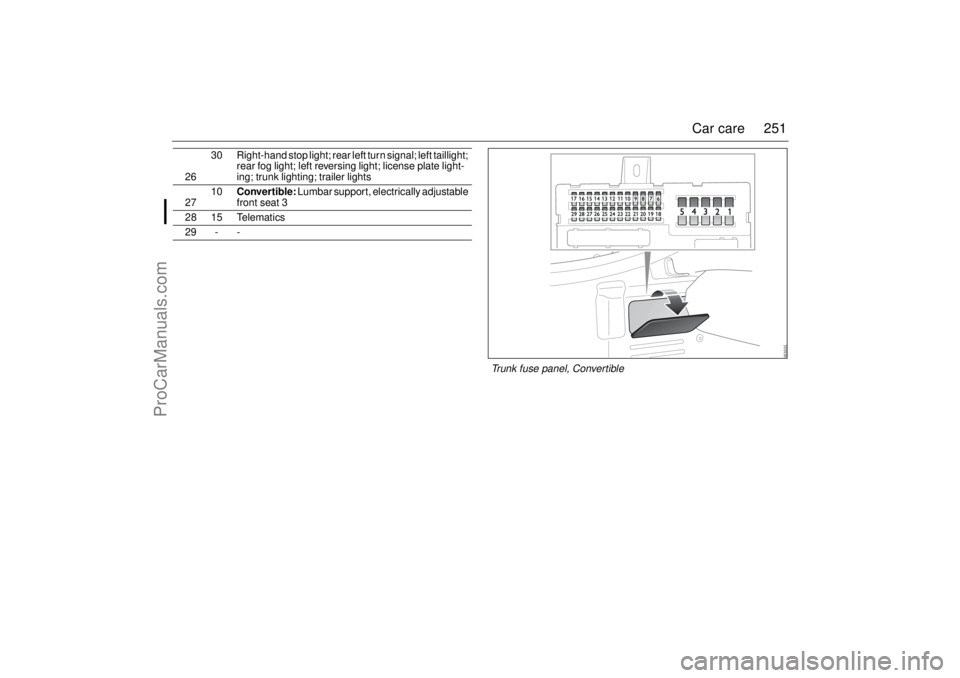
251 Car care
2630 Right-hand stop light; rear left turn signal; left taillight;
rear fog light; left reversing light; license plate light-
ing; trunk lighting; trailer lights
2710Convertible: Lumbar support, electrically adjustable
front seat3
28 15 Telematics
29 - -
Trunk fuse panel, Convertible
93U S M 06.book Page 251 Friday, February 18, 2005 1:15 PM
ProCarManuals.com
Page 252 of 318
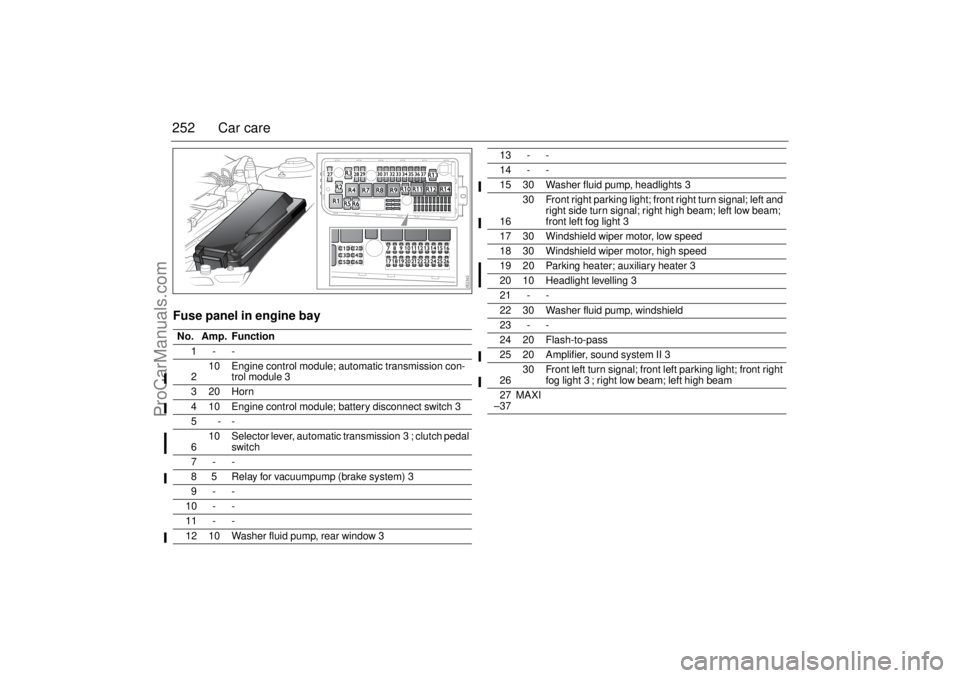
252 Car careFuse panel in engine bayNo. Amp. Function
1--
210 Engine control module; automatic transmission con-
trol module3
320Horn
4 10 Engine control module; battery disconnect switch3
5--
610 Selector lever, automatic transmission3; clutch pedal
switch
7--
8 5 Relay for vacuumpump (brake system)3
9--
10 - -
11 - -
12 10 Washer fluid pump, rear window3
13 - -
14 - -
15 30 Washer fluid pump, headlights3
1630 Front right parking light; front right turn signal; left and
right side turn signal; right high beam; left low beam;
front left fog light3
17 30 Windshield wiper motor, low speed
18 30 Windshield wiper motor, high speed
19 20 Parking heater; auxiliary heater3
20 10 Headlight levelling3
21 - -
22 30 Washer fluid pump, windshield
23 - -
24 20 Flash-to-pass
25 20 Amplifier, sound system II3
2630 Front left turn signal; front left parking light; front right
fog light3; right low beam; left high beam
27
–37MAXI
93U S M 06.book Page 252 Friday, February 18, 2005 1:15 PM
ProCarManuals.com
Page 253 of 318
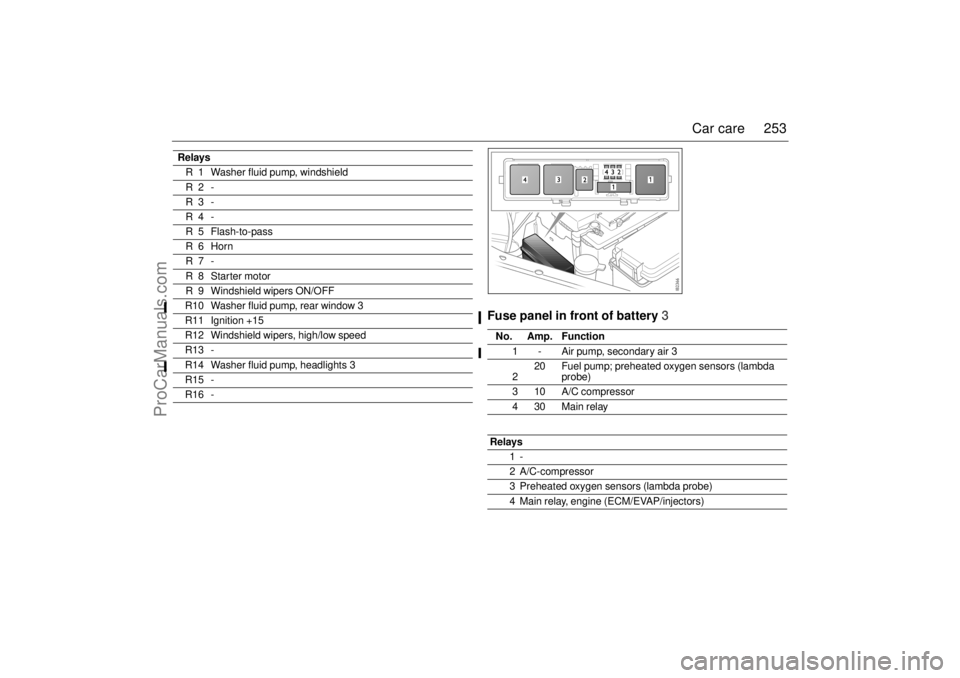
253 Car care
Fuse panel in front of battery3
Relays
R 1 Washer fluid pump, windshield
R2 -
R3 -
R4 -
R 5 Flash-to-pass
R6 Horn
R7 -
R8 Starter motor
R 9 Windshield wipers ON/OFF
R10 Washer fluid pump, rear window3
R11 Ignition +15
R12 Windshield wipers, high/low speed
R13 -
R14 Washer fluid pump, headlights3
R15 -
R16 -
No. Amp. Function
1 - Air pump, secondary air3
220 Fuel pump; preheated oxygen sensors (lambda
probe)
310A/C compressor
430Main relay
Relays
1-
2 A/C-compressor
3 Preheated oxygen sensors (lambda probe)
4 Main relay, engine (ECM/EVAP/injectors)
93U S M 06.book Page 253 Friday, February 18, 2005 1:15 PM
ProCarManuals.com
Page 254 of 318
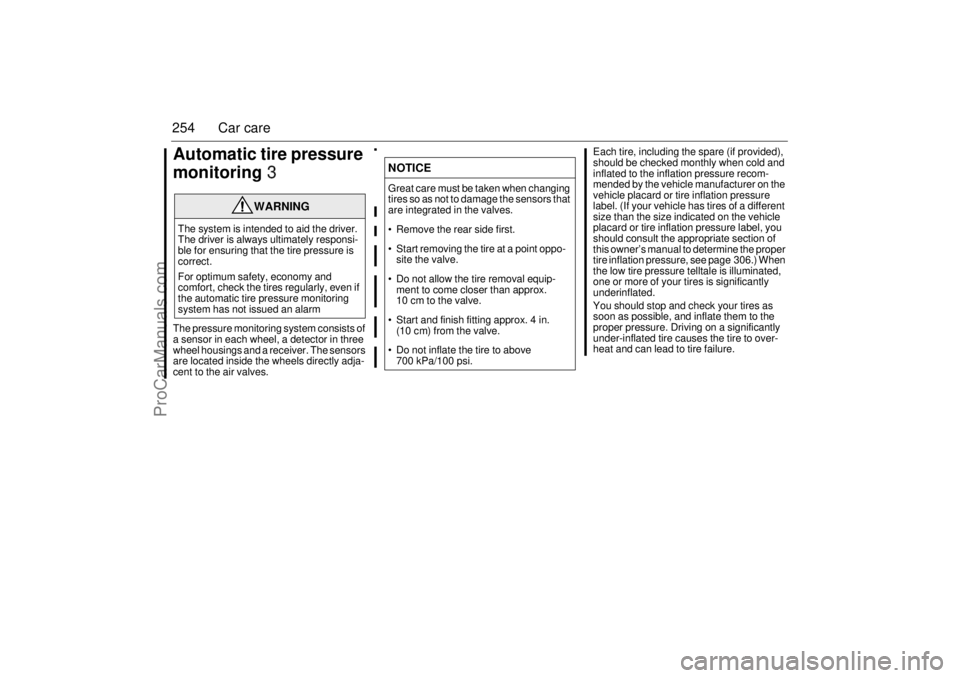
254 Car careAutomatic tire pressure
monitoring3The pressure monitoring system consists of
a sensor in each wheel, a detector in three
wheel housings and a receiver. The sensors
are located inside the wheels directly adja-
cent to the air valves.Each tire, including the spare (if provided),
should be checked monthly when cold and
inflated to the inflation pressure recom-
mended by the vehicle manufacturer on the
vehicle placard or tire inflation pressure
label. (If your vehicle has tires of a different
size than the size indicated on the vehicle
placard or tire inflation pressure label, you
should consult the appropriate section of
this owner’s manual to determine the proper
tire inflation pressure, see page 306.) When
the low tire pressure telltale is illuminated,
one or more of your tires is significantly
underinflated.
You should stop and check your tires as
soon as possible, and inflate them to the
proper pressure. Driving on a significantly
under-inflated tire causes the tire to over-
heat and can lead to tire failure.
WARNING
The system is intended to aid the driver.
The driver is always ultimately responsi-
ble for ensuring that the tire pressure is
correct.
For optimum safety, economy and
comfort, check the tires regularly, even if
the automatic tire pressure monitoring
system has not issued an alarm
NOTICEGreat care must be taken when changing
tires so as not to damage the sensors that
are integrated in the valves.
Remove the rear side first.
Start removing the tire at a point oppo-
site the valve.
Do not allow the tire removal equip-
ment to come closer than approx.
10 cm to the valve.
Start and finish fitting approx. 4 in.
(10 cm) from the valve.
Do not inflate the tire to above
700 kPa/100 psi.
93U S M 06.book Page 254 Friday, February 18, 2005 1:15 PM
ProCarManuals.com
Page 255 of 318

255 Car care
Under-inflation also reduces fuel efficiency
and tire tread life, and may affect the vehi-
cle’s handling and stopping ability.
Your vehicle has also been equipped with a
TPMS malfunction telltale to indicate when
the system is not operating properly. When
the malfunction telltale is illuminated, the
system may not be able to detect or signal
low tire pressure as intended. TPMS mal-
functions may occur for a variety of reasons,
including the installation of incompatible
replacement tires on the vehicle. Always
check the TPMS malfunction telltale after
replacing one or more tires on your vehicle
to ensure that the replacement tires are
compatible with the TPMS.
Tire pressure information is sent wirelessly
to the receiver.
The system checks the tire pressure when
the car is travelling over 18 mph (30 km/h).
The system is “self-learning”, which means
that the position of the wheels can be
changed without requiring adjustments to
the monitoring system. The spare wheel
does not have a sensor.
The sensor batteries have an average life of
10 years. The batteries cannot be changed
but require the sensor units to be replaced.
The system does not warn if a tire is overin-
flated.If the tire pressure drops
If the tire pressure drops 25% or more below
highest recommended pressure (see tire
pressure label on page 267), the SID will
issue a warning as to which tire is affected.
Adjust the tire pressure as soon as possible.If the vehicle is equipped with a different
wheel size than those fitted as standard and
therefore should use a different recom-
mended highest tire pressure the owner
shall contact a workshop to have the system
recalibrated. We recommend that you
contact a Saab dealer. Low tire pressure,
front left.
Make a safe stop.
Valve without sensor
Valve with sensor
93U S M 06.book Page 255 Friday, February 18, 2005 1:15 PM
ProCarManuals.com
Page 256 of 318
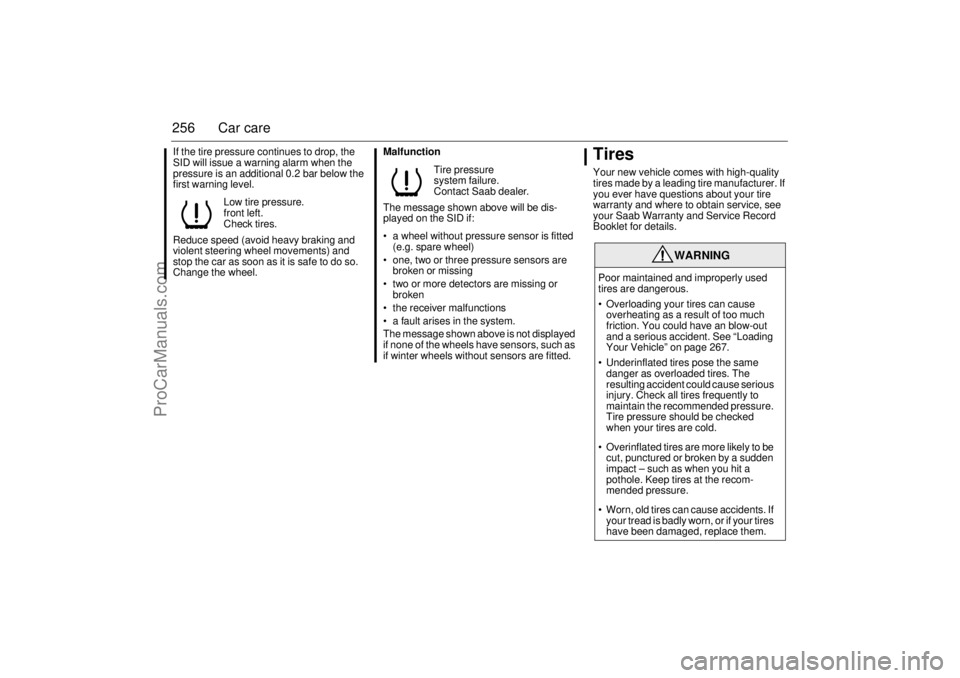
256 Car careIf the tire pressure continues to drop, the
SID will issue a warning alarm when the
pressure is an additional 0.2 bar below the
first warning level.
Reduce speed (avoid heavy braking and
violent steering wheel movements) and
stop the car as soon as it is safe to do so.
Change the wheel.Malfunction
The message shown above will be dis-
played on the SID if:
a wheel without pressure sensor is fitted
(e.g. spare wheel)
one, two or three pressure sensors are
broken or missing
two or more detectors are missing or
broken
the receiver malfunctions
a fault arises in the system.
The message shown above is not displayed
if none of the wheels have sensors, such as
if winter wheels without sensors are fitted.
TiresYour new vehicle comes with high-quality
tires made by a leading tire manufacturer. If
you ever have questions about your tire
warranty and where to obtain service, see
your Saab Warranty and Service Record
Booklet for details. Low tire pressure.
front left.
Check tires.
Tire pressure
system failure.
Contact Saab dealer.
WARNING
Poor maintained and improperly used
tires are dangerous.
Overloading your tires can cause
overheating as a result of too much
friction. You could have an blow-out
and a serious accident. See “Loading
Your Vehicle” on page 267.
Underinflated tires pose the same
danger as overloaded tires. The
resulting accident could cause serious
injury. Check all tires frequently to
maintain the recommended pressure.
Tire pressure should be checked
when your tires are cold.
Overinflated tires are more likely to be
cut, punctured or broken by a sudden
impact – such as when you hit a
pothole. Keep tires at the recom-
mended pressure.
Worn, old tires can cause accidents. If
your tread is badly worn, or if your tires
have been damaged, replace them.
93U S M 06.book Page 256 Friday, February 18, 2005 1:15 PM
ProCarManuals.com
Page 257 of 318

257 Car care
Inflation - Tire PressureThe Tire-Loading Information label shows
the correct inflation pressures for your tires
when they’re cold. “Cold” means your vehi-
cle has been sitting for at least three hours
or driven no more than 1 mile (1.6 km).Notice:
Don’t let anyone tell you that
underinflation or overinflation is all
right. It’s not. If your tires don’t have
enough air (underinflation), you can get
the following:
Too much flexing
Too much heat
Tire overloading
Bad wear
Bad handling
Bad fuel economy
If your tires have too much air (overinfla-
tion), you can get the following:
Unusual wear
Bad handling
Rough ride
Needless damage from road hazardsAdjust the tire pressure to match the current
load and speed of the car (see page 306).
The stated tire pressures apply to cold tires,
i.e. tires that are the same temperature as
the outside air temperature. Tire pressure
increases as the tires become warm (e.g.
during highway driving) by approximately
4 psi (28 kPa). When the temperature of the
tires changes by 50°F (10°C), the tire pres-
sure will change 2 psi (14 kPa).
Never reduce the pressure of a hot tire. If the
tires are hot when you check them, only
increase the pressure, if necessary.
High speed operation
WARNING
Driving at high speeds, 100 mph
(160 km/h) or higher, puts an additional
strain on tires.
Sustained high-speed driving causes
excessive heat build up and can cause
sudden tire failure. You could have a
crash and you or others could be killed.
Some high-speed rated tires require infla-
tion pressure adjustment for high speed
operation. When speed limits and road
conditions are such that a vehicle can be
driven at high speeds, make sure the tires
are rated for high speed operation, in
excellent condition, and set to the correct
cold tire inflation pressure for the vehicle
load.
93U S M 06.book Page 257 Friday, February 18, 2005 1:15 PM
ProCarManuals.com
Page 258 of 318
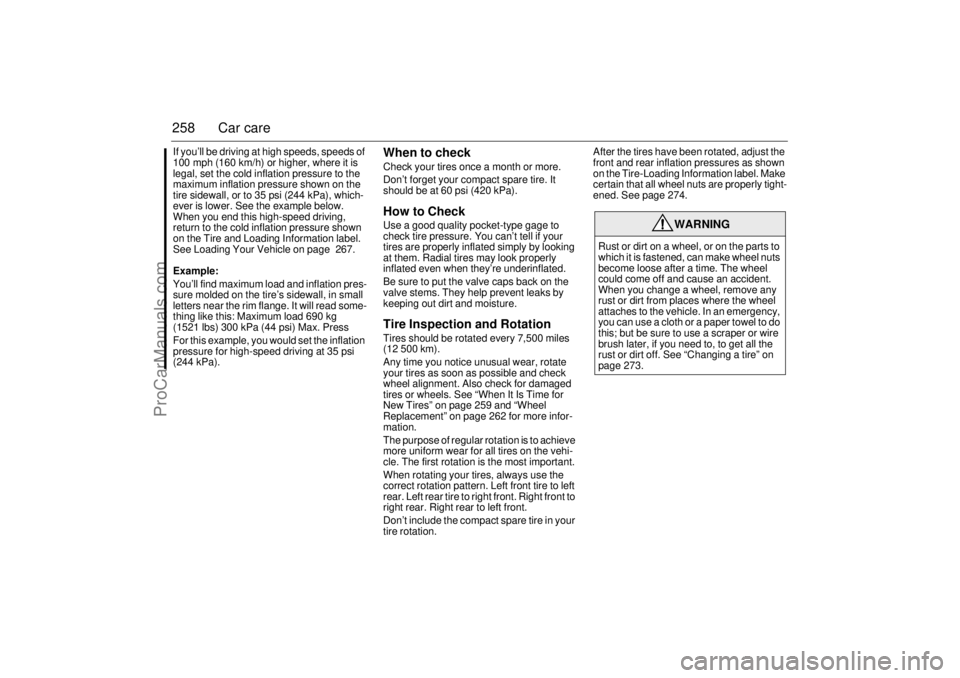
258 Car careIf you’ll be driving at high speeds, speeds of
100 mph (160 km/h) or higher, where it is
legal, set the cold inflation pressure to the
maximum inflation pressure shown on the
tire sidewall, or to 35 psi (244 kPa), which-
ever is lower. See the example below.
When you end this high-speed driving,
return to the cold inflation pressure shown
on the Tire and Loading Information label.
See Loading Your Vehicle on page 267.
Example:
You’ll find maximum load and inflation pres-
sure molded on the tire’s sidewall, in small
letters near the rim flange. It will read some-
thing like this: Maximum load 690 kg
(1521 lbs) 300 kPa (44 psi) Max. Press
For this example, you would set the inflation
pressure for high-speed driving at 35 psi
(244 kPa).
When to checkCheck your tires once a month or more.
Don’t forget your compact spare tire. It
should be at 60 psi (420 kPa).How to CheckUse a good quality pocket-type gage to
check tire pressure. You can’t tell if your
tires are properly inflated simply by looking
at them. Radial tires may look properly
inflated even when they’re underinflated.
Be sure to put the valve caps back on the
valve stems. They help prevent leaks by
keeping out dirt and moisture.Tire Inspection and RotationTires should be rotated every 7,500 miles
(12 500 km).
Any time you notice unusual wear, rotate
your tires as soon as possible and check
wheel alignment. Also check for damaged
tires or wheels. See “When It Is Time for
New Tires” on page 259 and “Wheel
Replacement” on page 262 for more infor-
mation.
The purpose of regular rotation is to achieve
more uniform wear for all tires on the vehi-
cle. The first rotation is the most important.
When rotating your tires, always use the
correct rotation pattern. Left front tire to left
rear. Left rear tire to right front. Right front to
right rear. Right rear to left front.
Don’t include the compact spare tire in your
tire rotation.After the tires have been rotated, adjust the
front and rear inflation pressures as shown
on the Tire-Loading Information label. Make
certain that all wheel nuts are properly tight-
ened. See page 274.
WARNING
Rust or dirt on a wheel, or on the parts to
which it is fastened, can make wheel nuts
become loose after a time. The wheel
could come off and cause an accident.
When you change a wheel, remove any
rust or dirt from places where the wheel
attaches to the vehicle. In an emergency,
you can use a cloth or a paper towel to do
this; but be sure to use a scraper or wire
brush later, if you need to, to get all the
rust or dirt off. See “Changing a tire” on
page 273.
93U S M 06.book Page 258 Friday, February 18, 2005 1:15 PM
ProCarManuals.com
Page 259 of 318
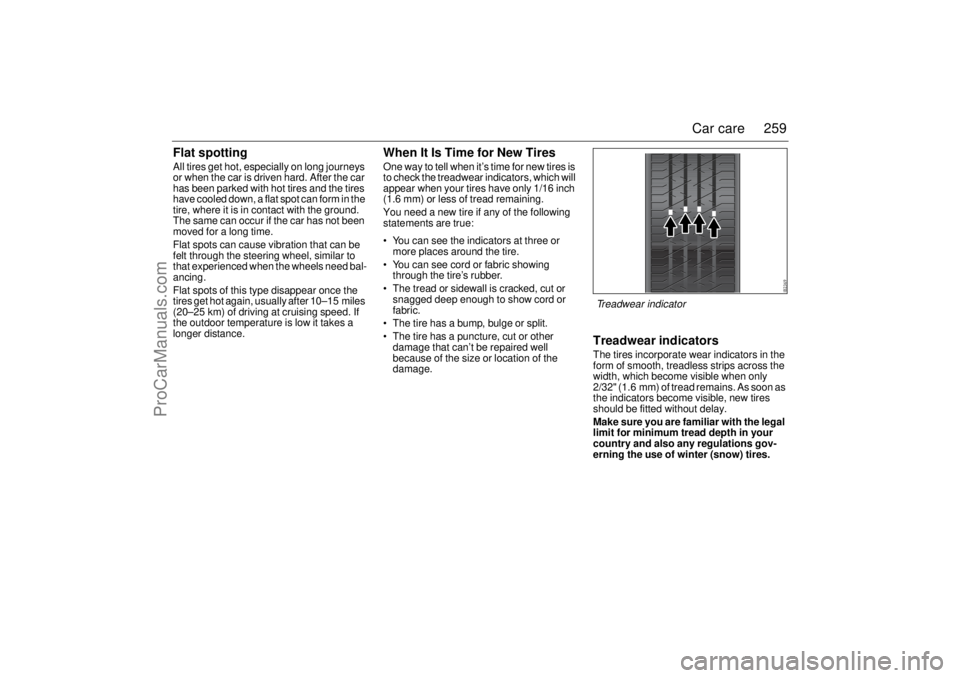
259 Car care
Flat spottingAll tires get hot, especially on long journeys
or when the car is driven hard. After the car
has been parked with hot tires and the tires
have cooled down, a flat spot can form in the
tire, where it is in contact with the ground.
The same can occur if the car has not been
moved for a long time.
Flat spots can cause vibration that can be
felt through the steering wheel, similar to
that experienced when the wheels need bal-
ancing.
Flat spots of this type disappear once the
tires get hot again, usually after 10–15 miles
(20–25 km) of driving at cruising speed. If
the outdoor temperature is low it takes a
longer distance.
When It Is Time for New TiresOne way to tell when it’s time for new tires is
to check the treadwear indicators, which will
appear when your tires have only 1/16 inch
(1.6 mm) or less of tread remaining.
You need a new tire if any of the following
statements are true:
You can see the indicators at three or
more places around the tire.
You can see cord or fabric showing
through the tire’s rubber.
The tread or sidewall is cracked, cut or
snagged deep enough to show cord or
fabric.
The tire has a bump, bulge or split.
The tire has a puncture, cut or other
damage that can’t be repaired well
because of the size or location of the
damage.
Treadwear indicatorsThe tires incorporate wear indicators in the
form of smooth, treadless strips across the
width, which become visible when only
2/32" (1.6 mm) of tread remains. As soon as
the indicators become visible, new tires
should be fitted without delay.
Make sure you are familiar with the legal
limit for minimum tread depth in your
country and also any regulations gov-
erning the use of winter (snow) tires.Treadwear indicator
93U S M 06.book Page 259 Friday, February 18, 2005 1:15 PM
ProCarManuals.com
Page 260 of 318

260 Car careBuying New TiresTo find out what kind and size of tires you
need, look at the Tire-Loading Information
label.
If you wish to fit other tires or wheels than
those supplied with the car, consult your
Saab dealer first as to the possibilities
available.
Wheels/tires combinations that are not
approved by Saab can negatively affect the
car’s directional stability, steering and brak-
ing in both wet and dry conditions.The wheels and tires have been carefully
matched to the characteristics of the car and
play a key role in its outstanding roadhold-
ing and handling.
Do not take it for granted that a wheel/tire
combination will work in the best possible
way, just because it can be fitted to the car.
To ensure that the speedometer is as accu-
rate as possible it should be reprogrammed
if wheels of a different dimension are fitted.
Contact a Saab dealer.
Because of front wheel drive, the front tires
tend to wear faster than the rear ones. New
tires should always be fitted in pairs, so that
tires on the same axle have the same
amount of tread.
Store wheels lying flat or hanging – never
standing upright.
NOTICEAlways consult your Saab dealer before
changing the car’s wheels or tires on your
Saab.
Wide wheels and tires with side walls that
are too low can:
be damaged in potholes, etc.
cause springs, shock absorbers and
wheel bearings and body mountings
to be overloaded.
affect the function of the Electronic
Stability Program (ESP).
The speed and load limits of the tires
must not be exceeded; see page 266.
Wheels larger than 17" must not be fitted
on the Saab 9-3 for reasons above. The
permissible offset is 1.61 inch (41 mm).
93U S M 06.book Page 260 Friday, February 18, 2005 1:15 PM
ProCarManuals.com